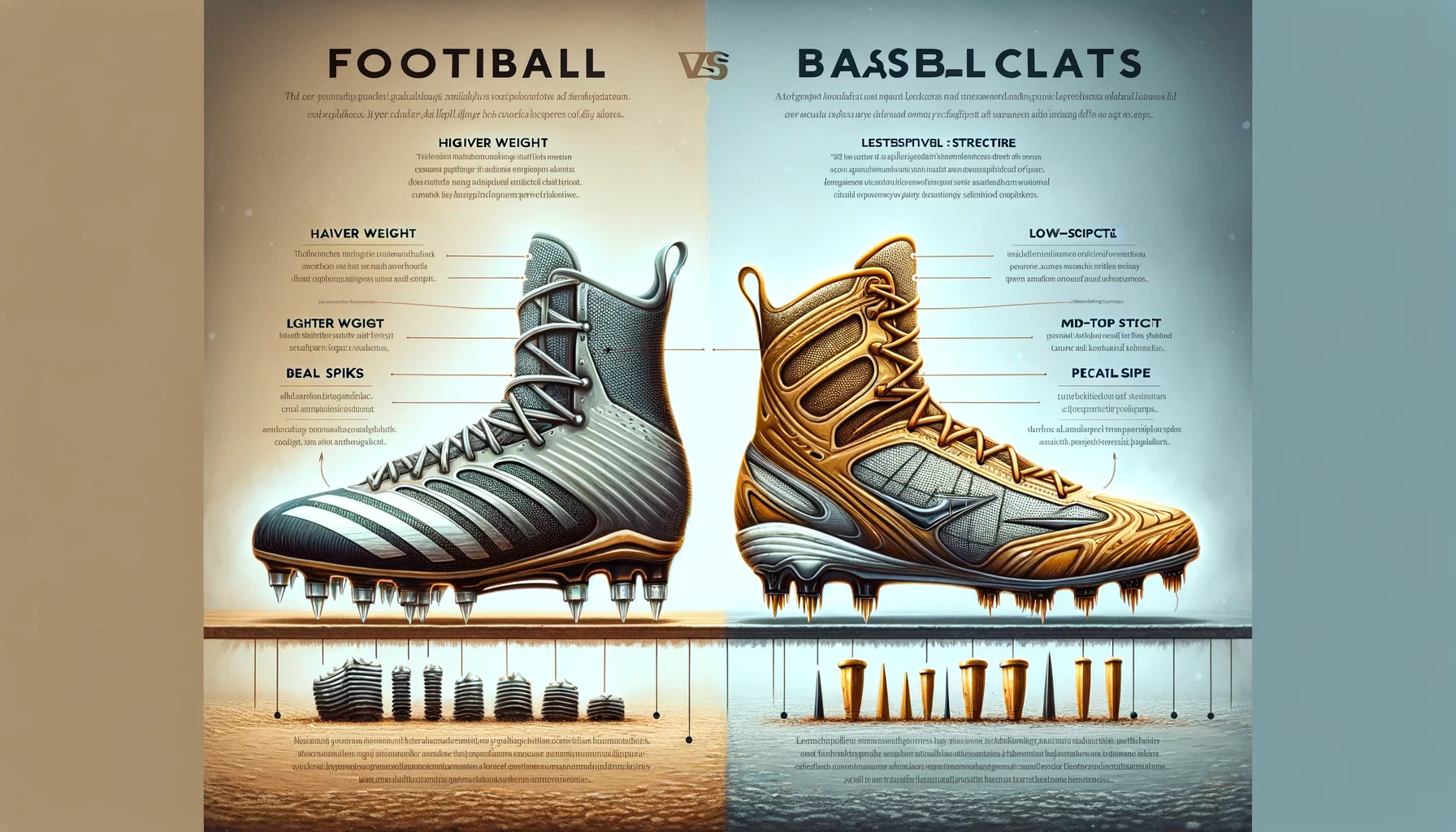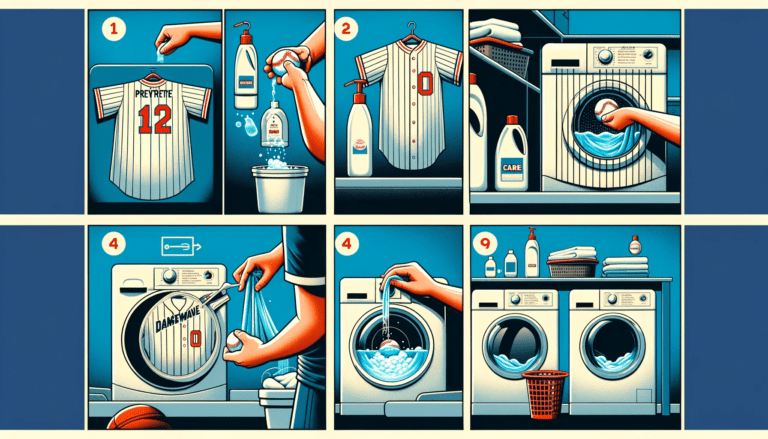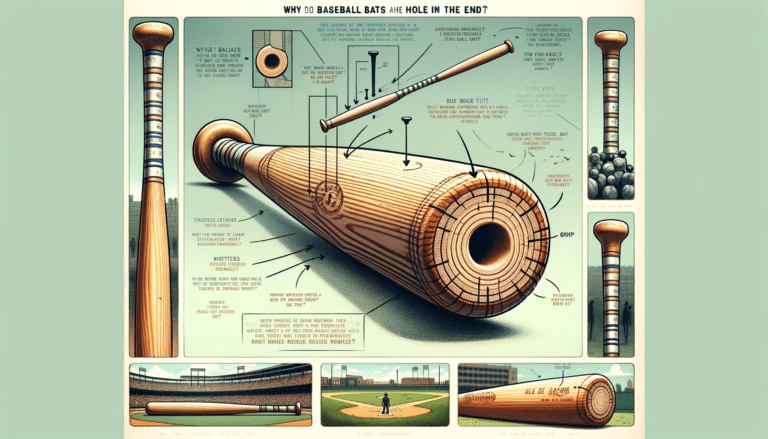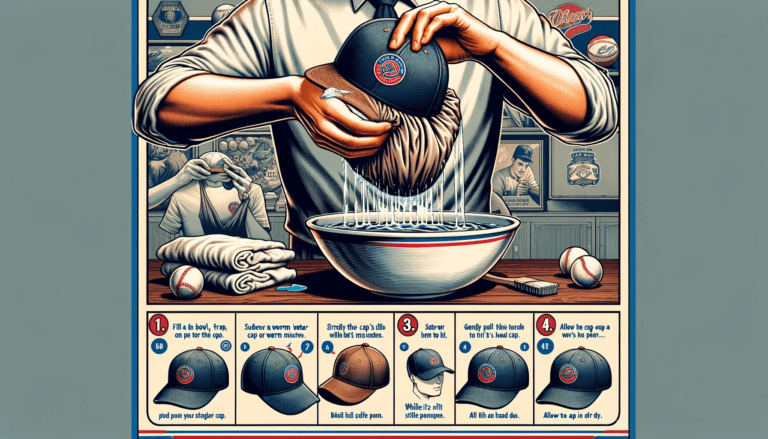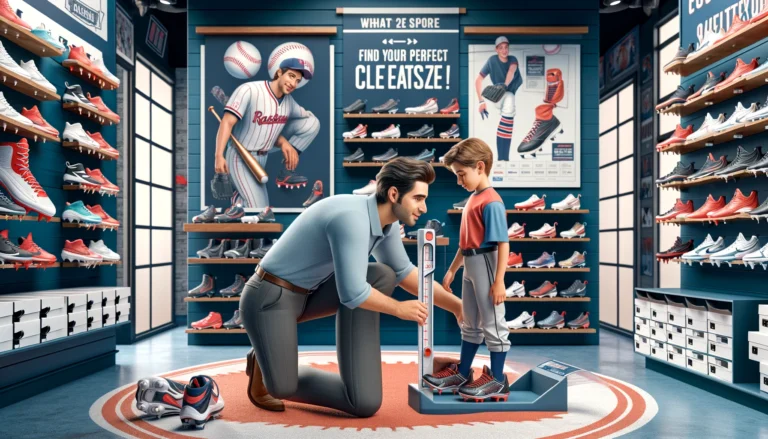What is the Difference Between Football Cleats and Baseball Cleats?
Choosing the right cleats for your sport is crucial for performance and safety. Football and baseball may seem similar, but their cleats are designed differently. Wearing the wrong cleats can lead to injuries or poor traction on the field.
Many athletes mistakenly think any pair of cleats will work for any sport. But the truth is, that football and baseball have distinct movements and field surfaces that require specialized cleat designs. Using football cleats on a baseball diamond or vice versa can be downright dangerous.
Understanding the key differences between football cleats vs baseball cleats will help you make the right choice. Football cleats have toe studs for better traction when making sharp cuts and lateral movements on grass fields.
Baseball cleats have fewer studs concentrated on the front for traction when running bases on dirt/clay fields. With the right cleats, you’ll move better and avoid nagging injuries.
Key Takeaways
- Football and baseball cleats are designed with specific features to enhance performance in their respective sports, with differences in spike configuration and technology.
- Baseball cleats often feature a toe cleat for quick starts and stops, while football cleats focus on various spike lengths and patterns for multidirectional movement.
- Materials and construction of cleats have evolved, with innovations like the REVlite midsole in baseball cleats offering lightweight cushioning without sacrificing durability.
- The choice of cleats can be influenced by the type of field, with options like metal cleats for superior grip and TPU outsoles for versatility and multi-sport use.
- Proper maintenance, including cleaning techniques and timely replacement, is essential to preserve the condition and performance of athletic cleats.
Understanding the Basics of Cleats

The Role of Cleats in Athletic Performance
Cleats play a pivotal role in enhancing athletic performance across various sports.
They provide the necessary traction and stability that athletes need to execute movements with precision and speed. Different sports require cleats with specific features tailored to the demands of the game.
For instance, football cleats are designed to offer stability and grip during lateral movements and quick direction changes. They usually lack the front toe cleat seen in baseball cleats, which is crucial for quick starts and stops.
On the other hand, baseball cleats come in various options that cater to different field types, ensuring comfort and stability for the player.
When selecting cleats, it’s important to consider the type of sport, field conditions, and personal comfort preferences.
Here’s a quick guide to help you understand the basics:
- Football Cleats: Focus on grip and lateral stability.
- Baseball Cleats: Offer a front toe cleat for quick movements.
- Soccer Cleats: Designed for control and maneuvering the ball.
- Track Spikes: Provide maximum traction during sprints.
Choosing the right cleat is a step towards maximizing your performance and dominating the game.
Different Types of Cleats for Various Sports
Cleats are specialized shoes designed to provide athletes with the necessary traction and stability on various playing surfaces.
Different sports require different types of cleats, each tailored to the specific demands and movements of the one playing surface sport.
For instance:
- Baseball Cleats typically have a toe cleat to provide extra grip when running the bases.
- Soccer Cleats are known for their low-profile cushioning to enhance ball feel.
- Football Cleats come in various styles for different positions, with some offering extra ankle support.
- Track Spikes are lightweight and have sharp spikes for maximum traction during sprints.
Selecting the right cleat is crucial for maximizing performance and ensuring player safety. It’s important to choose a cleat that is suitable for the field type and provides the necessary comfort and stability.
Whether you’re a power hitter in baseball or a lineman in football, the right cleats can make a significant difference in your game.
Materials and Construction of Modern Cleats
The evolution of modern cleats has led to a significant focus on the materials and construction used to enhance athletic performance.
Innovative materials such as synthetic leather and mesh are commonly employed to provide a balance of durability and breathability.
These lightweight materials) are often combined in a way that maximizes comfort without sacrificing the structural integrity needed for rigorous sports activities.
Modern cleats also feature advanced midsole technologies, like the lightweight and responsive REVlite midsole, which offers premium cushioning.
This is crucial for athletes who require both comfort and performance on the field. The construction of cleats may include a Kinetic Stitch or similar methods to deliver zonal strength, ensuring flexibility where it’s most needed.
When selecting cleats, it’s important to consider the type of spikes used. Metal cleats, for instance, are known for their superior grip but may not be suitable for all field types.
Non-metal options are available for players who play soccer and need versatility across different playing surfaces.
Ultimately, the choice of materials and construction should align with the player’s needs for comfort, stability, and performance.
Read Also: What is the Difference Between Baseball Cleats and Soccer Cleats
Exploring the Baseball Cleats

Key Features of Baseball Cleats
Baseball cleats are designed with a unique set of features to enhance player performance on the diamond.
Molded cleats are a popular choice, known for their durable plastic or rubber construction. These cleats come with studs that are strategically arranged to provide a reliable grip on various playing surfaces, including both natural and artificial fields.
The 9-Spike Advanced TPU Outsole is a notable innovation, offering excellent traction that is suitable for multi-sport use, including baseball, lacrosse, and softball.
This outsole is complemented by a full-length midsole that delivers heel-to-toe cushioning, ensuring ultimate comfort throughout the game.
Additionally, the Kinetic Stitch TPU-coated upper found in some models like the 4040v5 baseball cleat, offers zonal strength without compromising flexibility, which is crucial for the dynamic movements in baseball.
When selecting baseball cleats, it’s important to consider the type of field and the player’s specific needs.
For instance, a non-metal cleat design is ideal for all field types and focuses on eliminating concerns over comfort and stability. This allows players to maximize their performance and dominate the game without any distractions.
How Baseball Cleats Enhance Player Performance
Baseball cleats are engineered to maximize baseball players” performance on the field. The strategic design of the cleats’ spikes provides superior grip, which is crucial for quick starts, stops, and direction changes.
This grip is especially beneficial when batting, allowing players to plant their feet on the ground more firmly and generate more power during their swing.
The midsole technology plays a pivotal role in comfort and support. A full-length midsole, for example, offers heel-to-toe cushioning that can help reduce fatigue for a game.
Additionally, features like the Kinetic Stitch TPU-coated upper contribute to both flexibility and zonal strength, ensuring that the cleat moves with the foot while still providing necessary support.
Selecting the right baseball cleats can also have a significant impact on a player’s performance.
Here are some key considerations:
- The type of spike (metal or molded) suitable for the field type
- The level of cushioning and support needed
- The fit and comfort of the cleat, which can vary by brand and model
By addressing these factors, players can enhance their stability and comfort on the field, leading to improved performance and a reduced risk of injury.
Selecting the Right Baseball Cleats for the Field Type
Choosing the appropriate baseball cleats for the field type is crucial for both performance and safety.
The right cleats can significantly affect a player’s traction ball control and stability on different playing surfaces.
For instance, metal cleats are typically favored for their grip on dirt and grass fields, but they may not be allowed on synthetic turfs due to safety concerns and field damage risks.
When selecting cleats, consider the following:
- The material of the cleat’s spikes, with options like metal, molded plastic, or turf-specific designs.
- The type of field you’ll be playing on most often, whether it’s natural grass, artificial turf, or a combination of both.
- The league regulations, as some leagues have restrictions on the use of metal spikes.
Ultimately, soccer players should opt for a cleat that offers comfort, and stability and is suitable for all field types if versatility is needed.
Products like the 4040v5 baseball cleat, with its REVlite midsole and flexible 8-spike plate, provide a balance of lightweight performance and support across various surfaces.
Read Also: What is the Difference Between Softball and Baseball Cleats
Exploring Football Cleats
Design Innovations in Football Cleats
Football cleats have undergone significant design innovations to meet the rigorous demands of the sport.
The introduction of the ultra-light REVlite midsole is a game-changer, providing players with premium responsiveness and durability while being 30% lighter than comparable foams.
This technological advancement ensures that players can maintain speed and agility without sacrificing comfort.
Key design features include:
- A flexible yet supportive 8-spike plate that adapts to various field conditions.
- The Kinetic Stitch TPU-coated upper offers zonal strength and flexibility, crucial for multidirectional movement.
- Strategic cushioning and low profile cleats enhance grip and reduce the strain on the athlete’s feet during intense play.
These innovations are tailored to eliminate concerns over comfort and stability, allowing players to focus on maximizing their performance and dominating the game.
As football continues to evolve, so too do the cleats, with manufacturers constantly seeking ways to provide athletes with a competitive edge.
The Importance of Traction and Stability in Football
In the high-stakes world of pro football, however, traction and stability are paramount for players to execute their roles effectively.
The cleats worn by football athletes are engineered to provide the necessary grip on the field, which is crucial for sudden changes in direction, acceleration, and overall agility.
- Traction is essential for maintaining speed and executing sharp turns without slipping.
- Stability ensures that players can withstand tackles and maintain their balance during play.
Selecting the right cleats can make a significant difference in a player’s ability to perform. A cleat that is suitable for all field types offers a versatile solution, especially for those who need a non-metal option.
The design of football cleats focuses on eliminating concerns over comfort and stability, thus allowing players to maximize their performance and dominate the game.
Choosing Football Cleats for Position-Specific Advantages
Selecting the right football cleats is crucial for enhancing a player’s performance on the field. Different positions require different types of cleats to maximize efficiency and effectiveness during play.
For example, a wide receiver might opt for lightweight cleats that allow for explosive speed and agility, such as the adidas Adizero Spark Cleats.
When choosing cleats, consider the following:
- The type of field surface you’ll be playing on
- The position you play and the specific needs associated with it
- The level of ankle support and protection required
It’s also important to look for cleats that offer a balance between comfort and stability, to help dominate the game without the worry of discomfort.
Innovations like the Nike Vapor Edge Pro 360 2 provide players with advanced traction and stability, tailored to the demands of modern football.
Comparing Baseball and Football Cleats
Differences in Cleat Spikes and Traction
The spikes and traction systems of baseball and football cleats are engineered to meet the specific demands of each sport.
Baseball cleats typically feature a toe cleat, which helps players’ toes gain traction when taking off from a stationary position, such as when stealing bases or sprinting to first base.
In contrast, football cleats do not have this toe spike because it can cause injury during tackles.
Baseball cleats often come with either metal or molded spikes. Metal spikes are sharper and provide more traction but are not allowed in all leagues due to safety concerns.
Molded spikes, made from TPU or rubber, offer durability and are generally considered safer. Football cleats, on the other hand, may vary more in spike shape and layout to optimize for different playing positions.
When comparing traction, football cleats usually have a wider range of spike lengths and configurations to accommodate the various types of playing surfaces, from natural grass to synthetic turf surfaces.
The traction pattern is also designed to provide stability during lateral movements, which are common in football.
Here’s a quick rundown of the differences:
- Baseball cleats: Toe cleats, metal or molded spikes, designed for linear speed.
- Football cleats: No toe cleat, varied spike shapes, designed for multi-directional movement and stability.
Midsole Technology and Player Comfort
The midsole is a critical component in athletic cleats, providing the cushioning and support that athletes need for peak performance.
Baseball and football cleats feature advanced midsole technologies designed to offer both comfort and responsiveness on the field.
Baseball cleats, such as the Mizuno 9-Spike Advanced, boast a full-length midsole for heel-to-toe cushioning, while football cleats like the 4040v5 incorporate a REVlite midsole for lightweight, durable heel support.
Key aspects of midsole technology include:
- Responsiveness to quick movements
- Durability to withstand the rigors of the sport
- Lightweight construction for unencumbered agility
Selecting the right cleat with the appropriate midsole technology can significantly affect an athlete’s comfort level during the game.
It’s essential to consider the balance between cushioning and stability when choosing cleats, as this can impact performance and reduce the risk of injury.
Whether it’s the soft flexibility and enhanced cushioning of the Dominant IC TPU for baseball or the strategic cushion placement in football cleats, the right choice will help athletes stay comfortable and perform at their best.
Adaptability for Multi-Sport Athletes
For multi-sport athletes, the adaptability of cleats across different sports can be a significant factor in both performance and budget.
Choosing the right cleats that can transition between sports can save time and money, while also reducing the need for multiple pairs of specialized footwear.
- 9-Spike Advanced TPU Outsole: Designed for versatility, this feature is common in cleats that are suitable for multiple sports, providing reliable traction on various surfaces.
- Full length midsole: Ensures heel to toe cushioning, which is crucial for comfort during long games or practices, regardless of the sport.
However, it’s important to note that not all cleats are created equal. For example, using baseball cleats for your lacrosse cleats might not be advisable due to the potential for injuries stemming from design differences and unsuitability for the sport’s specific movements.
Always consider the demands of each sport and choose accordingly to ensure safety and optimal performance.
Maintenance and Care for Athletic Cleats
Proper Cleaning Techniques for Longevity
Maintaining your athletic cleats is crucial for ensuring they last as long as possible. Regular cleaning is the first step towards preserving both the material and the structure of your cleats.
Begin by removing any loose dirt or debris with a soft-bristled brush. For a deeper clean, use a mild soap and warm water to gently scrub the cleats, paying special attention to areas where dirt accumulates.
After cleaning, it’s important to dry your cleats properly. Avoid direct heat sources like radiators or hair dryers, as they can damage the material.
Instead, stuff the cleats with newspaper to absorb moisture maintain shape, and let them air dry. Once dry, condition the cleat material well, especially if it’s leather, to prevent cracking and to keep the cleats supple.
Remember, the way you treat your cleats off the field can be just as important as how you perform on it.
Excessive wear, such as playing on inappropriate surfaces like concrete, can significantly shorten the lifespan of your cleats.
Keep an eye on the overall condition of the cleats and address any issues promptly to ensure they remain in top playing condition.
When to Replace Your Cleats
Knowing when to replace your cleats is crucial for maintaining performance and safety on the field.
A good rule of thumb is to inspect your cleats regularly for signs of wear and tear. Look for worn-down spikes, which can compromise traction, and pay attention to the overall condition of the upper material and midsole cushioning.
- Inspect the cleat spikes for wear and tear
- Check the midsole and upper for signs of excessive wear
- Consider the age of the cleats; most have a lifespan of one season
If you notice that the cleats are unevenly worn, or the cushioning has become too compressed, it’s time for a new pair.
Additionally, if you’ve had the same cleats for over a season and they’ve seen regular use, it’s wise to invest in a new set to ensure optimal performance and prevent injuries.
Storing Cleats to Maintain Optimal Condition
Proper storage of cleats is crucial to extend their lifespan and maintain their condition.
Store your cleats in a cool, dry place away from direct sunlight to prevent the materials from degrading. It’s also important to avoid damp areas which can lead to the growth of mold and odor.
After ensuring your cleats are clean and dry, consider using a dedicated storage solution, such as a sports equipment organizer.
These often come with baskets and hooks, which are perfect for neatly storing cleats alongside other gear.
For example, a Garage Sports Equipment Storage Organizer can keep your cleats easily accessible while protecting them from damage.
Lastly, to retain the shape of your cleats, stuff them with newspaper or a shoe tree. This will help to absorb any residual moisture and prevent the cleats from warping or losing form over time.
Conclusion
In summary, both football and baseball cleats offer unique features tailored to their respective sports.
Football cleats are designed with a focus on traction, stability, and support for lateral movements, while baseball cleats prioritize flexibility, comfort, and grip for quick sprints and base running.
The choice between the two ultimately depends on the specific needs of the athlete and the demands of the sport they are engaged in.
Players need to consider the type of field they will be playing on, the position they play, and their personal preferences for comfort and performance.
Whether it’s the lightweight and flexible design of the 4040v5 baseball cleat or the superior grip and cushioning of the metal football cleat, there is a perfect fit for every player looking to elevate their game.
Frequently Asked Questions
What are the main differences between baseball and football cleats?
Baseball cleats typically have a toe cleat to enhance push-off for quick movements and may have metal spikes, while football cleats typically do not have a toe cleat and often feature a variety of spike shapes and patterns for multi-directional traction.
Can I use baseball cleats for football, or vice versa?
It’s not recommended as each sport has specific requirements for traction, movement, and safety. Using the correct type of cleats for each sport is important for performance and injury prevention.
What is the significance of midsole technology in athletic cleats?
Midsole technology, such as the REVlite midsole found in some baseball cleats, provides cushioning and support, affecting the responsiveness, durability, and overall comfort of the cleats.
How do I choose the right cleats for my position in football?
Football players should choose cleats based on their position’s demands. For example, linemen may prefer cleats with more ankle support, while receivers might opt for lightweight and flexible options.
How often should I replace my athletic cleats?
Cleats should be replaced when they show significant wear, such as worn-down spikes or compromised structural integrity, which can affect performance and safety.
What is the best way to maintain my cleats in optimal condition?
Proper maintenance includes regular cleaning, drying them out completely after use, and storing them in a cool, dry place to prevent damage and odor.

